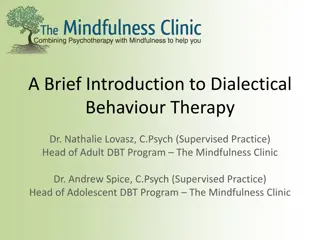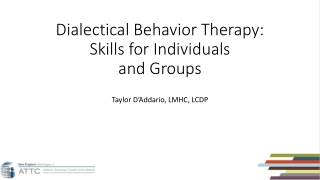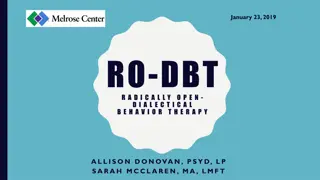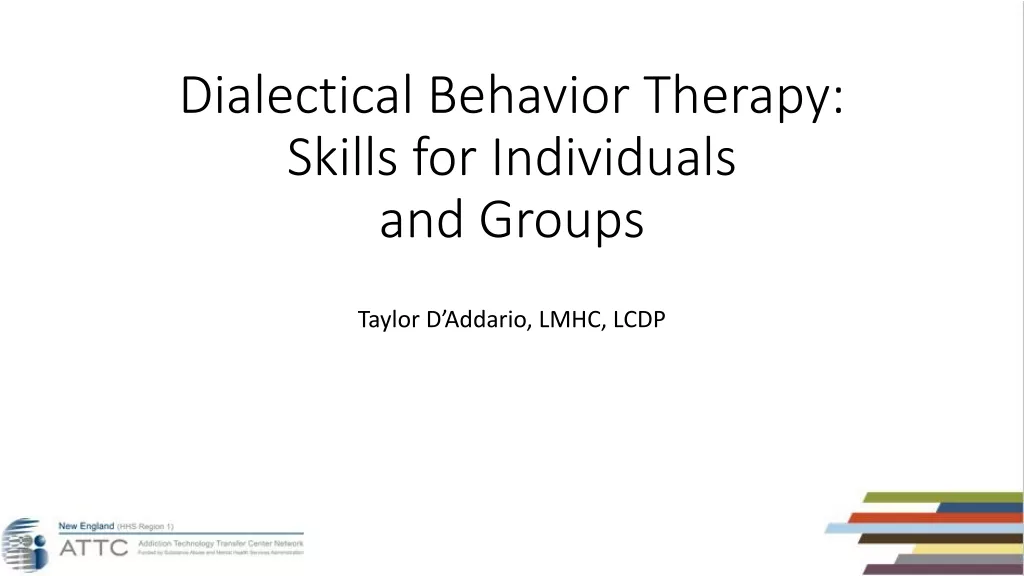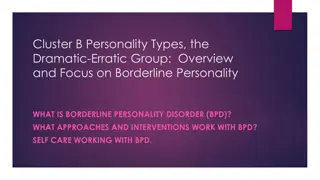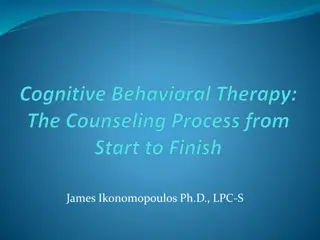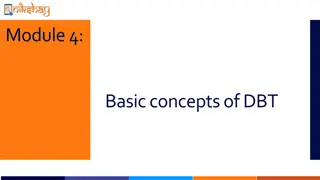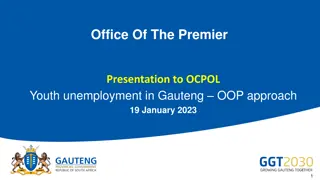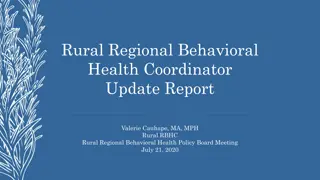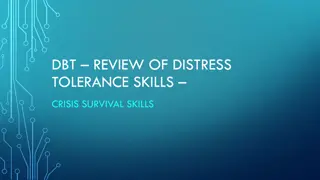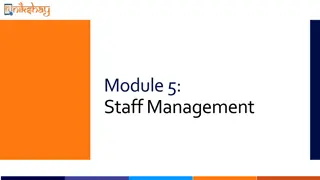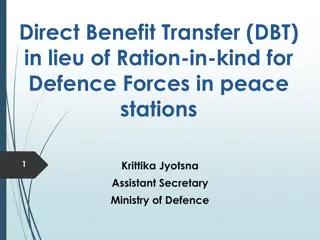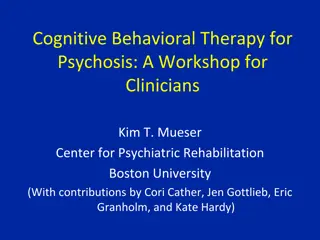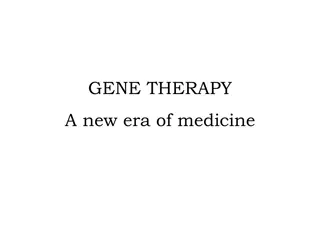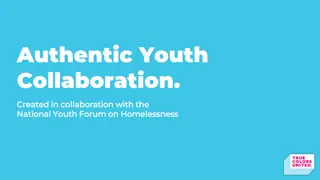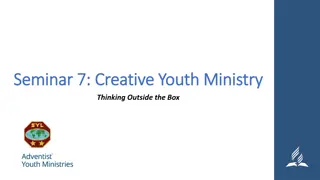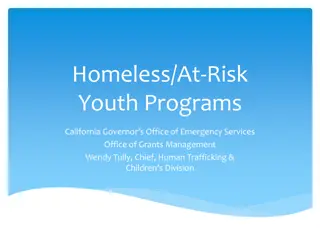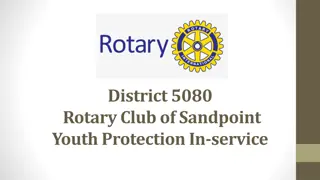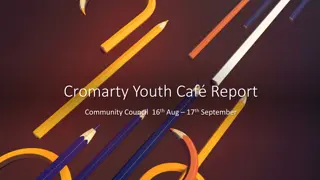Understanding Dialectical Behavioral Therapy (DBT) for Youth
Explore the comprehensive practice of Dialectical Behavioral Therapy (DBT) aimed at enhancing emotional regulation in youth. Learn about different types of emotions, DBT goals, radical acceptance, program overview, dialectics, biosocial theory, and emotional dysregulation. Discover the tools and skills involved, along with the importance of finding balance and managing biological vulnerability to emotions.
Download Presentation

Please find below an Image/Link to download the presentation.
The content on the website is provided AS IS for your information and personal use only. It may not be sold, licensed, or shared on other websites without obtaining consent from the author. Download presentation by click this link. If you encounter any issues during the download, it is possible that the publisher has removed the file from their server.
E N D
Presentation Transcript
DIALECTICAL BEHAVIORAL THERAPY (DBT) FOR YOUTH EDGEWOOD CENTER Mark Purcell, PsyD
Different Types of Emotions Calm SAD Anger Anger LOVE LOVE Pain PainConfused Confused Worried GUILT GUILT Worried
DBT Goals Increase Target Behaviors Dysregulation TOOLS: Diary Card Behavior Chain TOOLS: DBT Skills Group
RADICAL ACCEPTANCE 4 Grant me the serenity to ACCEPT the things I cannot change, Courage to CHANGE the things I can, And WISDOM to know the difference.
DBT Program Overview Skills for Coping As Needed Weekly Weekly Skills Coach Behavior Coach Individual Therapist Skills Group Leaders Diary Cards Skills Training Target Behaviors Youth & Coach
Dialectics Finding Balance Dialectics Involves integrating seemingly opposing views Similar to Eastern Concepts of Non-Duality Use the word And instead of But One Set of Needs or Wants Opposing Needs or Wants Acceptance Change Trust Suspicion Dependence Independence Careful, Too Fearful Impulsive, Reckless Surrender Protect/Fight Focus on Self Focus on Others
Biosocial Theory I am Stupid... Invalidating Environment Biological Vulnerability You re so stupid! There s something wrong with me I don t understand why you re so upset I don t deserve to live Behavioral Problems I wish you were never born Confusion about self; impulsivity; emotional instability; interpersonal problems
Emotional Dysregulation Biological Vulnerability to Emotions (Sensitive Wiring) Low Emotional Modulation High Sensitivity Immediate reactions Reactions with only a little provocation High Reactivity Extreme reactions High arousal makes thinking clearly difficult Slow return to baseline Long-lasting reactions Higher sensitivity to next emotional event Difficulties with changing one s own emotions Difficulties with paying attention (e.g., in class) when emotions are felt Difficulty in stopping from acting right away when emotions are felt
Consequences of invalidating Environment By not validating feelings, the environment does not teach the individual to: Label feelings Effectively regulate emotions Trust feelings By making problem solving seem easier than it is, the environment does not teach the individual to: Effectively tolerate stress Form realistic goals and expectations When communication of anger or sadness is punished and/or when only intense anger or sadness are responded to, the environment teaches the individual to: Vary between having no emotions and having extreme emotions.
Types of Dysregulation Emotional Interpersonal Self Behavioral Cognitive
DIALECTICAL BEHAVIOR THERAPY Problems (Behaviors to Decrease) Skills (Behaviors to Increase) Confusion about your self Mindfulness Impulsivity Distress Tolerance Emotional Instability Emotional Regulation Interpersonal Problems Interpersonal Effectiveness Parent-Youth Problems Middle Path
Validation VALIDATIONCOMMUNICATESTOANOTHERPERSONTHATHIS/HERFEELINGS, THOUGHTS, ANDACTIONSMAKESENSE ANDAREUNDERSTANDABLETOYOUINAPARTICULARSITUATION. VALIDATION AGREEMENT WHAT SHOULDWEVALIDATE? FEELINGS, THOUGHTS, ANDBEHAVIORSIN: OURSELVES OTHER PEOPLE WHY SHOULDWEVALIDATE? ITIMPROVESRELATIONSHIPS VALIDATIONCANSHOWTHAT: WEARELISTENING WEUNDERSTAND WEARENOTBEINGJUDGMENTAL WECAREABOUTTHERELATIONSHIP CONFLICTISPOSSIBLEWITHDECREASEDINTENSITYANDANGER
Levels of Validation Validation Level Goal of Interaction One Listen Non-Judgmentally Two Accurate Reflection Three Articulate Unspoken Thoughts and Feelings Four Understanding Historical Background of Behavior Confirming Thoughts, Behaviors and Feelings Based on Current Circumstances Five Six Radical Genuineness & Authenticity
Interaction of Emotions, Thoughts, & Behaviors
Matching Skills with Level of Dysregulation EMOTIONAL DYSREGULATION Distress Tolerance Emotional Regulation Interpersonal Effectiveness Mindfulness
Commitment Strategies Selling it, evaluating pros and cons Devil s advocate Foot-in-the-door technique Freedom to choose in absence of alternatives Shaping
Orientation Strategies Therapeutic Alliance Connect problems to areas of dysregulation and skill development Define problems as targets Link long-term goals to targets Introduce biosocial theory Introduce tx format/characteristics Introduce diary cards Review agreements Use commitment strategies
Pre-Treatment Goals Agreement on Goals Commitment to change Initial targets of treatment Agreement to Recommended Tx. Client agreements Therapist agreements Agreement to Therapist-Client Relationship
Treatment Goals Level 1: Severe Behavioral Dyscontrol Level 2: Quiet Desperation Level 3: Problems in Living Level 4: Incompleteness
Stage 1 Targets Decrease Life-threatening/high-risk behaviors Therapy-interfering behaviors Quality of life interfering behaviors Increase behavioral skills Mindfullness, distress tolerance, interpersonal effectiveness, emotional regulation
Therapy-Interfering Behaviors Client Non-compliance Non-collaborative Non-attending Behaviors that interfere with other clients Pushing therapists limits Reduce therapist s motivation to treat
Therapy-Interfering Behavior Therapist Extreme acceptance or change Extreme flexibility to rigidity Extreme nurturing or withholding Extreme vulnerability or irreverence Disrespectful Behaviors
Quality of Life Interfering Behaviors Incapacitating DSM Disorder High risk sexual behavior Extreme financial difficulties Criminal behaviors Severe interpersonal dysfuntion Unemployment, severe school problems Physical health, dysfunctional behaviors Severe housing difficulties
Adol. Secondary Targets Excessive leniency vs. authoritarian control Normalizing pathological behaviors vs. pathologizing normative behaviors Forcing autonomy vs. fostering dependence
Diary Cards Track and observe behaviors in real time Structure Session Spring board to Chain and Solution Analysis Integration of Skills
Chain Analysis vuVULNERABILIES PROMTING EVENTS PROBLEM BEHAVIOR CONSEQUENCES
Solution Analysis Identify goals, needs, desires Generate solutions Evaluate solutions Choose a solution to implement Troubleshoot solution
Responding to Problems Solve the problem Change emotional reaction to problem Tolerate/accept the problem Stay miserable
DBT Consultation Agreements To accept a dialectical philosophy To consult with patient on how to interact with other therapists Consistency of therapists is not expected Observe own limits, without judgment
Consultation Agreements Cont Search for non-pejorative, empathic interpretation of client s behavior All therapists are fallible
DBT Team Responsibilities Plan and trouble shoot treatment Monitoring adherence to DBT Progress towards DBT competence Consult to the therapist Support to therapist and team members
DBT SKILLS MODULE I MINDFULNESS
States of Mind W I S E M I N D
States of Mind Emotional Mind Feeling - Centered Logical thinking is difficult Facts are distorted to match mood You may be impulsive or Hot Headed Emotions are in control Emotions influence and control your thinking & behavior Operate in Emo Mode Wise Mind Thoughts + Feelings Integrate best of emotional & rational minds Viewing situation with loving detachment Observing & responding Not Intense Reacting Not Cool Distancing Operate in Wise Mode Rational Mind Thought centered Emotions are ignored Focus on Facts & Logic Feelings of self & others not considered Cool and detached Operate in Robot Mode
What Skills Just notice the experience Watch your thoughts and feelings come and go Do not push away your thoughts and feelings, let them happen Notice what comes through your senses Observe Describe Put words on the experience. For example: I feel sad right now or My stomach muscles are tightening. Involve yourself in the experience or activity Fully experience feelings without being self-conscious Completely throw yourself into the current moment Don t worry about tomorrow, or about what happened yesterday Just focus on whatever is actually happening Participate
How Skills Don t evaluate Stick to just the facts Accept the moment Just acknowledge the emotion- don t get pulled into it Don t judge your judging Don t Judge Focus Mindfully Focus on one thing at a time Let go of distractions Focus on what works for you Act as skillfully as you can. Play by the rules Keep your eye on what you want in the long run Do what you need to achieve your goals Let go of vengeance, useless anger, and feelings that hurt you and do not work Do What Works
Dialectics Finding Balance One Set of Needs or Wants Opposing Needs or Wants Acceptance Change Trust Suspicion Dependence Independence Careful, Too Fearful Impulsive, Reckless Follow Rules Do What We Want Focus on Self Focus on Others
DBT MODULE II: DISTRESS TOLERANCE Presented by Mark Purcell. PsyD
Avoidance & Acceptance 42 Pain Pain Avoidance Acceptance Suffering Mindfulness
Crisis Survival Skills: Distract with ACCEPTS 43 Activity Engage in exercise or a favorite hobby Contributing Contribute to something Do something for someone else Comparison Compare yourself now to past times when you may have suffered even more Emotions Listen to music; read books; go to movies Be sure the event creates different emotions Pushing Away Push the situation away by leaving it for a while mentally Do something to engage your mind Count to ten. Read an engaging book Thoughts Engage all your senses Squeeze a ball, or ice; listen to music; dance Sensations
Crisis Survival Skills: Self Soothe with the Senses 44 Vision Look at a picture or poster that you like. Look at the stars. Look at nature around you. Hearing Listen to beautiful or soothing music. Pay attention to the sounds of nature (waves, birds, rainfall). Smell Put on your favorite lotion/perfume/ cologne. Boil cinnamon. Bake. Light a scented candle. Taste Really taste the food you eat. Have a good meal. Have your favorite soothing drink (tea, hot chocolate). Touch Take a bubble bath or hot shower. Have a massage. Hug someone. Brush or braid your hair.
IMPROVE the Moment 45 Imagery Imagine a calming and safe place Imagine stress and anxiety draining out Meaning Find a meaning or value to what you are suffering. Focus on positive, growth from challenges. Prayer Turn things over to a Higher Power Find support, strength, or faith to cope Relaxation Use deep breathing and follow your breath Use muscle relaxation and other ways to relax One thing Focus you attention on one thing in the moment. Keep yourself physically and mentally in present
Urge Surfing 46 Ramp down Every urge has three phases. Peak Ramp-up period begins at trigger point or event, when the idea of doing the behavior first arises. Ramp Up The peak is the intense high point of the urge. Ramp-down or fall off period as things gradually return to baseline TO Urge Surf: Breath deep and have willingness to reduce the urge and let go of the behavior as a solution for pain. Remove yourself from the situation if you can. Relax the body and practice breathing or calming techniques while staying mindful and present-focused.
Pros & Cons of Change 47 PROS CONS Engage in Ineffective Behavior CHANGE Do Something Different
Distress Tolerance Review 48 Distraction When Distressed Doing something else until Wise ACCEPTS Soothing with Senses Self-soothing during difficult times Helping yourself feel better Getting through difficult moments Making meaning out of tough times IMPROVE Getting through urge to engage in impulsive behaviors Urge Surfing 9/11/2024
RADICAL ACCEPTANCE 49 Grant me the serenity to ACCEPT the things I cannot change, Courage to CHANGE the things I can, And WISDOM to know the difference.
DBT MODULE III: EMOTIONAL REGULATION Presented by Mark Purcell, PsyD


